Reverse Logistics: Strategies, Challenges, and Future Directions
VerifiedAdded on 2022/11/26
|45
|14168
|275
Report
AI Summary
This report provides a comprehensive overview of reverse logistics research, drawing from multiple sources including journal articles and research papers. It covers various aspects of reverse logistics, such as production routing problems with reverse logistics and remanufacturing, information flow-centric approaches for reverse logistics supply chains, and chain-to-chain competition in forward and reverse logistics. The report also explores the use of fuzzy AHP-TOPSIS approaches for prioritizing solutions to reverse logistics barriers, and provides a literature review and perspectives in reverse logistics, including forecasting product returns, outsourcing, and RL networks from a secondary market perspective. The research emphasizes the growing importance of reverse logistics due to environmental concerns, legislation, and corporate social responsibility, and highlights the evolving nature of research in this field, addressing issues related to adoption, implementation, and disposition decisions.

International Journal of Operations & Production Management
Strategic orientations, sustainable supply chain initiatives, and reverse logistics: empirical evidence
from an emerging market.
Chin-Chun Hsu Keah-Choon Tan Suhaiza Hanim Mohamad Zailani
Article information:
To cite this document:
Chin-Chun Hsu Keah-Choon Tan Suhaiza Hanim Mohamad Zailani , (2016),"Strategic orientations, sustainable supply
chain initiatives, and reverse logistics: empirical evidence from an emerging market.", International Journal of Operations &
Production Management, Vol. 36 Iss 1 pp. -
Permanent link to this document:
http://dx.doi.org/10.1108/IJOPM-06-2014-0252
Downloaded on: 04 November 2015, At: 19:36 (PT)
References: this document contains references to 0 other documents.
To copy this document: permissions@emeraldinsight.com
The fulltext of this document has been downloaded 12 times since 2016*
Access to this document was granted through an Emerald subscription provided by emerald-srm:376953 []
For Authors
If you would like to write for this, or any other Emerald publication, then please use our Emerald for Authors service
information about how to choose which publication to write for and submission guidelines are available for all. Plea
visit www.emeraldinsight.com/authors for more information.
About Emerald www.emeraldinsight.com
Emerald is a global publisher linking research and practice to the benefit of society. The company manages a portf
more than 290 journals and over 2,350 books and book series volumes, as well as providing an extensive range of
products and additional customer resources and services.
Emerald is both COUNTER 4 and TRANSFER compliant. The organization is a partner of the Committee on Publication
Ethics (COPE) and also works with Portico and the LOCKSS initiative for digital archive preservation.
*Related content and download information correct at time of download.
Downloaded by UNIVERSITY OF MALAYA At 19:36 04 November 2015 (PT)
Strategic orientations, sustainable supply chain initiatives, and reverse logistics: empirical evidence
from an emerging market.
Chin-Chun Hsu Keah-Choon Tan Suhaiza Hanim Mohamad Zailani
Article information:
To cite this document:
Chin-Chun Hsu Keah-Choon Tan Suhaiza Hanim Mohamad Zailani , (2016),"Strategic orientations, sustainable supply
chain initiatives, and reverse logistics: empirical evidence from an emerging market.", International Journal of Operations &
Production Management, Vol. 36 Iss 1 pp. -
Permanent link to this document:
http://dx.doi.org/10.1108/IJOPM-06-2014-0252
Downloaded on: 04 November 2015, At: 19:36 (PT)
References: this document contains references to 0 other documents.
To copy this document: permissions@emeraldinsight.com
The fulltext of this document has been downloaded 12 times since 2016*
Access to this document was granted through an Emerald subscription provided by emerald-srm:376953 []
For Authors
If you would like to write for this, or any other Emerald publication, then please use our Emerald for Authors service
information about how to choose which publication to write for and submission guidelines are available for all. Plea
visit www.emeraldinsight.com/authors for more information.
About Emerald www.emeraldinsight.com
Emerald is a global publisher linking research and practice to the benefit of society. The company manages a portf
more than 290 journals and over 2,350 books and book series volumes, as well as providing an extensive range of
products and additional customer resources and services.
Emerald is both COUNTER 4 and TRANSFER compliant. The organization is a partner of the Committee on Publication
Ethics (COPE) and also works with Portico and the LOCKSS initiative for digital archive preservation.
*Related content and download information correct at time of download.
Downloaded by UNIVERSITY OF MALAYA At 19:36 04 November 2015 (PT)
Paraphrase This Document
Need a fresh take? Get an instant paraphrase of this document with our AI Paraphraser
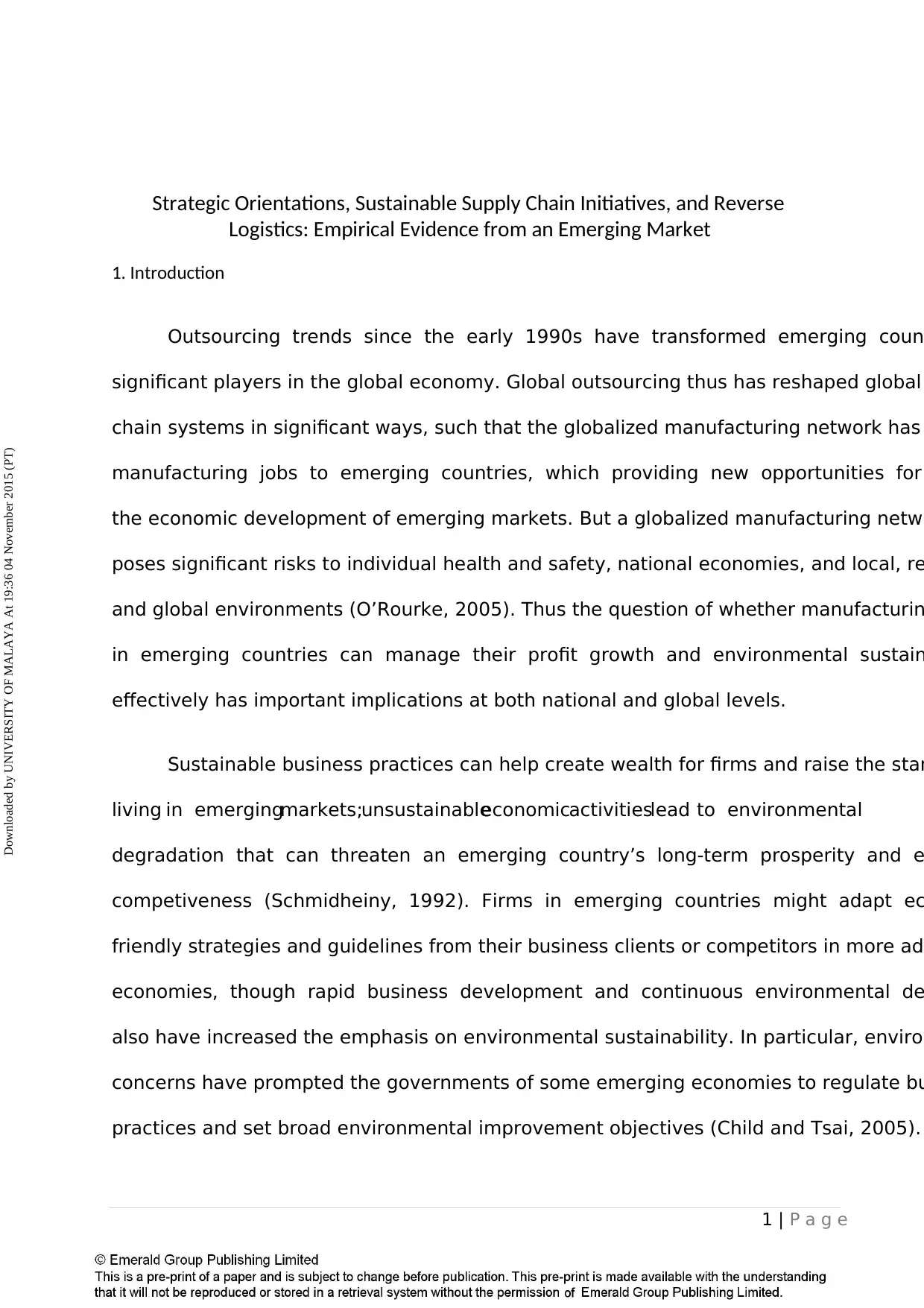
1 | P a g e
Strategic Orientations, Sustainable Supply Chain Initiatives, and Reverse
Logistics: Empirical Evidence from an Emerging Market
1. Introduction
Outsourcing trends since the early 1990s have transformed emerging coun
significant players in the global economy. Global outsourcing thus has reshaped global
chain systems in significant ways, such that the globalized manufacturing network has
manufacturing jobs to emerging countries, which providing new opportunities for
the economic development of emerging markets. But a globalized manufacturing netwo
poses significant risks to individual health and safety, national economies, and local, re
and global environments (O’Rourke, 2005). Thus the question of whether manufacturin
in emerging countries can manage their profit growth and environmental sustain
effectively has important implications at both national and global levels.
Sustainable business practices can help create wealth for firms and raise the stan
living in emergingmarkets;unsustainableeconomicactivitieslead to environmental
degradation that can threaten an emerging country’s long-term prosperity and e
competiveness (Schmidheiny, 1992). Firms in emerging countries might adapt ec
friendly strategies and guidelines from their business clients or competitors in more ad
economies, though rapid business development and continuous environmental de
also have increased the emphasis on environmental sustainability. In particular, environ
concerns have prompted the governments of some emerging economies to regulate bu
practices and set broad environmental improvement objectives (Child and Tsai, 2005).
Downloaded by UNIVERSITY OF MALAYA At 19:36 04 November 2015 (PT)
Strategic Orientations, Sustainable Supply Chain Initiatives, and Reverse
Logistics: Empirical Evidence from an Emerging Market
1. Introduction
Outsourcing trends since the early 1990s have transformed emerging coun
significant players in the global economy. Global outsourcing thus has reshaped global
chain systems in significant ways, such that the globalized manufacturing network has
manufacturing jobs to emerging countries, which providing new opportunities for
the economic development of emerging markets. But a globalized manufacturing netwo
poses significant risks to individual health and safety, national economies, and local, re
and global environments (O’Rourke, 2005). Thus the question of whether manufacturin
in emerging countries can manage their profit growth and environmental sustain
effectively has important implications at both national and global levels.
Sustainable business practices can help create wealth for firms and raise the stan
living in emergingmarkets;unsustainableeconomicactivitieslead to environmental
degradation that can threaten an emerging country’s long-term prosperity and e
competiveness (Schmidheiny, 1992). Firms in emerging countries might adapt ec
friendly strategies and guidelines from their business clients or competitors in more ad
economies, though rapid business development and continuous environmental de
also have increased the emphasis on environmental sustainability. In particular, environ
concerns have prompted the governments of some emerging economies to regulate bu
practices and set broad environmental improvement objectives (Child and Tsai, 2005).
Downloaded by UNIVERSITY OF MALAYA At 19:36 04 November 2015 (PT)
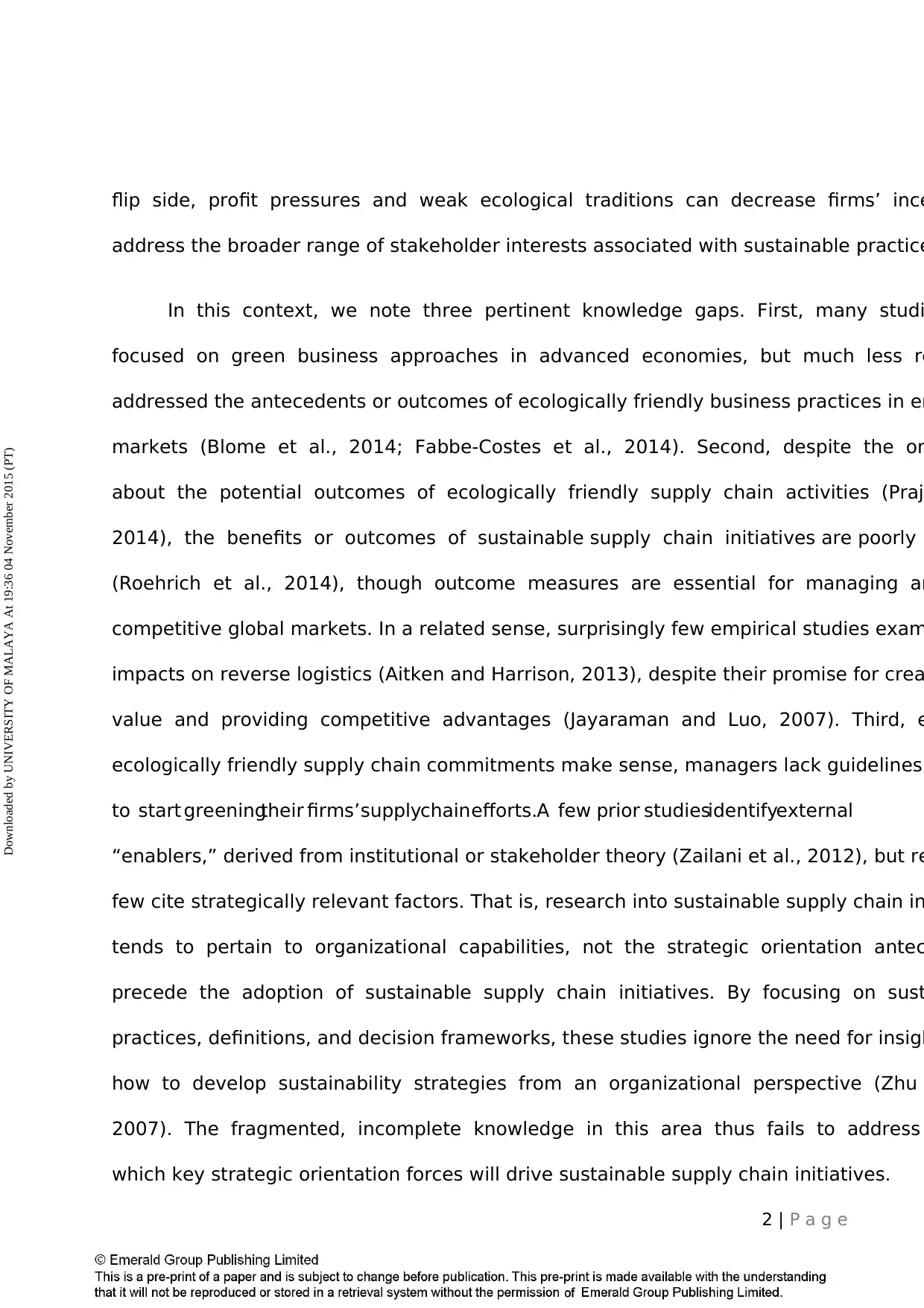
2 | P a g e
flip side, profit pressures and weak ecological traditions can decrease firms’ ince
address the broader range of stakeholder interests associated with sustainable practice
In this context, we note three pertinent knowledge gaps. First, many studi
focused on green business approaches in advanced economies, but much less re
addressed the antecedents or outcomes of ecologically friendly business practices in em
markets (Blome et al., 2014; Fabbe-Costes et al., 2014). Second, despite the on
about the potential outcomes of ecologically friendly supply chain activities (Praj
2014), the benefits or outcomes of sustainable supply chain initiatives are poorly
(Roehrich et al., 2014), though outcome measures are essential for managing an
competitive global markets. In a related sense, surprisingly few empirical studies exam
impacts on reverse logistics (Aitken and Harrison, 2013), despite their promise for crea
value and providing competitive advantages (Jayaraman and Luo, 2007). Third, e
ecologically friendly supply chain commitments make sense, managers lack guidelines
to start greeningtheir firms’supplychain efforts.A few prior studiesidentifyexternal
“enablers,” derived from institutional or stakeholder theory (Zailani et al., 2012), but re
few cite strategically relevant factors. That is, research into sustainable supply chain in
tends to pertain to organizational capabilities, not the strategic orientation antec
precede the adoption of sustainable supply chain initiatives. By focusing on sust
practices, definitions, and decision frameworks, these studies ignore the need for insigh
how to develop sustainability strategies from an organizational perspective (Zhu
2007). The fragmented, incomplete knowledge in this area thus fails to address
which key strategic orientation forces will drive sustainable supply chain initiatives.
Downloaded by UNIVERSITY OF MALAYA At 19:36 04 November 2015 (PT)
flip side, profit pressures and weak ecological traditions can decrease firms’ ince
address the broader range of stakeholder interests associated with sustainable practice
In this context, we note three pertinent knowledge gaps. First, many studi
focused on green business approaches in advanced economies, but much less re
addressed the antecedents or outcomes of ecologically friendly business practices in em
markets (Blome et al., 2014; Fabbe-Costes et al., 2014). Second, despite the on
about the potential outcomes of ecologically friendly supply chain activities (Praj
2014), the benefits or outcomes of sustainable supply chain initiatives are poorly
(Roehrich et al., 2014), though outcome measures are essential for managing an
competitive global markets. In a related sense, surprisingly few empirical studies exam
impacts on reverse logistics (Aitken and Harrison, 2013), despite their promise for crea
value and providing competitive advantages (Jayaraman and Luo, 2007). Third, e
ecologically friendly supply chain commitments make sense, managers lack guidelines
to start greeningtheir firms’supplychain efforts.A few prior studiesidentifyexternal
“enablers,” derived from institutional or stakeholder theory (Zailani et al., 2012), but re
few cite strategically relevant factors. That is, research into sustainable supply chain in
tends to pertain to organizational capabilities, not the strategic orientation antec
precede the adoption of sustainable supply chain initiatives. By focusing on sust
practices, definitions, and decision frameworks, these studies ignore the need for insigh
how to develop sustainability strategies from an organizational perspective (Zhu
2007). The fragmented, incomplete knowledge in this area thus fails to address
which key strategic orientation forces will drive sustainable supply chain initiatives.
Downloaded by UNIVERSITY OF MALAYA At 19:36 04 November 2015 (PT)
⊘ This is a preview!⊘
Do you want full access?
Subscribe today to unlock all pages.

Trusted by 1+ million students worldwide
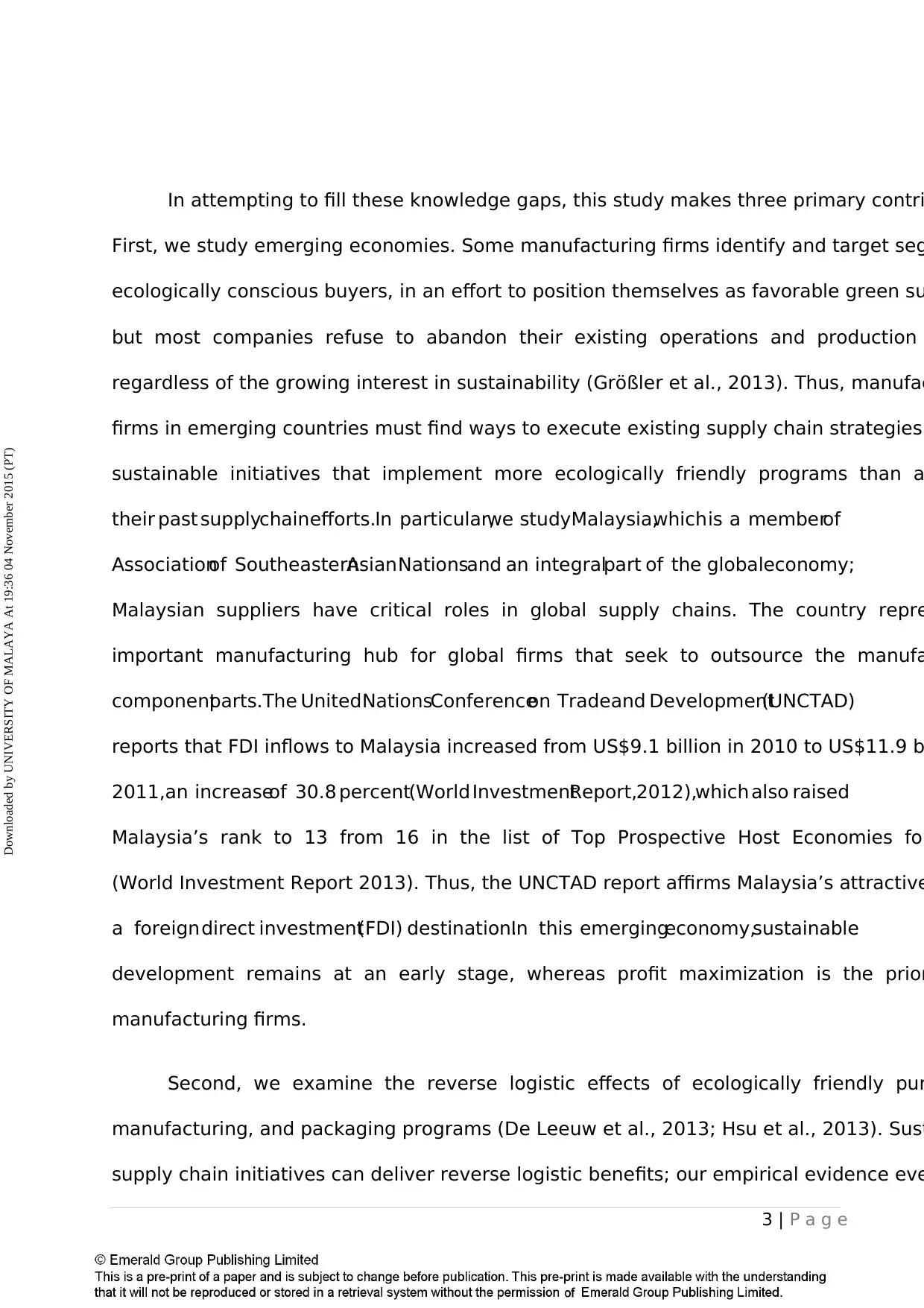
3 | P a g e
In attempting to fill these knowledge gaps, this study makes three primary contri
First, we study emerging economies. Some manufacturing firms identify and target seg
ecologically conscious buyers, in an effort to position themselves as favorable green su
but most companies refuse to abandon their existing operations and production
regardless of the growing interest in sustainability (Größler et al., 2013). Thus, manufac
firms in emerging countries must find ways to execute existing supply chain strategies
sustainable initiatives that implement more ecologically friendly programs than a
their past supplychainefforts.In particular,we studyMalaysia,which is a memberof
Associationof SoutheasternAsian Nationsand an integralpart of the globaleconomy;
Malaysian suppliers have critical roles in global supply chains. The country repre
important manufacturing hub for global firms that seek to outsource the manufa
componentparts.The UnitedNationsConferenceon Tradeand Development(UNCTAD)
reports that FDI inflows to Malaysia increased from US$9.1 billion in 2010 to US$11.9 b
2011,an increaseof 30.8 percent(World InvestmentReport,2012),which also raised
Malaysia’s rank to 13 from 16 in the list of Top Prospective Host Economies for
(World Investment Report 2013). Thus, the UNCTAD report affirms Malaysia’s attractive
a foreign direct investment(FDI) destination.In this emergingeconomy,sustainable
development remains at an early stage, whereas profit maximization is the prior
manufacturing firms.
Second, we examine the reverse logistic effects of ecologically friendly pur
manufacturing, and packaging programs (De Leeuw et al., 2013; Hsu et al., 2013). Sust
supply chain initiatives can deliver reverse logistic benefits; our empirical evidence eve
Downloaded by UNIVERSITY OF MALAYA At 19:36 04 November 2015 (PT)
In attempting to fill these knowledge gaps, this study makes three primary contri
First, we study emerging economies. Some manufacturing firms identify and target seg
ecologically conscious buyers, in an effort to position themselves as favorable green su
but most companies refuse to abandon their existing operations and production
regardless of the growing interest in sustainability (Größler et al., 2013). Thus, manufac
firms in emerging countries must find ways to execute existing supply chain strategies
sustainable initiatives that implement more ecologically friendly programs than a
their past supplychainefforts.In particular,we studyMalaysia,which is a memberof
Associationof SoutheasternAsian Nationsand an integralpart of the globaleconomy;
Malaysian suppliers have critical roles in global supply chains. The country repre
important manufacturing hub for global firms that seek to outsource the manufa
componentparts.The UnitedNationsConferenceon Tradeand Development(UNCTAD)
reports that FDI inflows to Malaysia increased from US$9.1 billion in 2010 to US$11.9 b
2011,an increaseof 30.8 percent(World InvestmentReport,2012),which also raised
Malaysia’s rank to 13 from 16 in the list of Top Prospective Host Economies for
(World Investment Report 2013). Thus, the UNCTAD report affirms Malaysia’s attractive
a foreign direct investment(FDI) destination.In this emergingeconomy,sustainable
development remains at an early stage, whereas profit maximization is the prior
manufacturing firms.
Second, we examine the reverse logistic effects of ecologically friendly pur
manufacturing, and packaging programs (De Leeuw et al., 2013; Hsu et al., 2013). Sust
supply chain initiatives can deliver reverse logistic benefits; our empirical evidence eve
Downloaded by UNIVERSITY OF MALAYA At 19:36 04 November 2015 (PT)
Paraphrase This Document
Need a fresh take? Get an instant paraphrase of this document with our AI Paraphraser
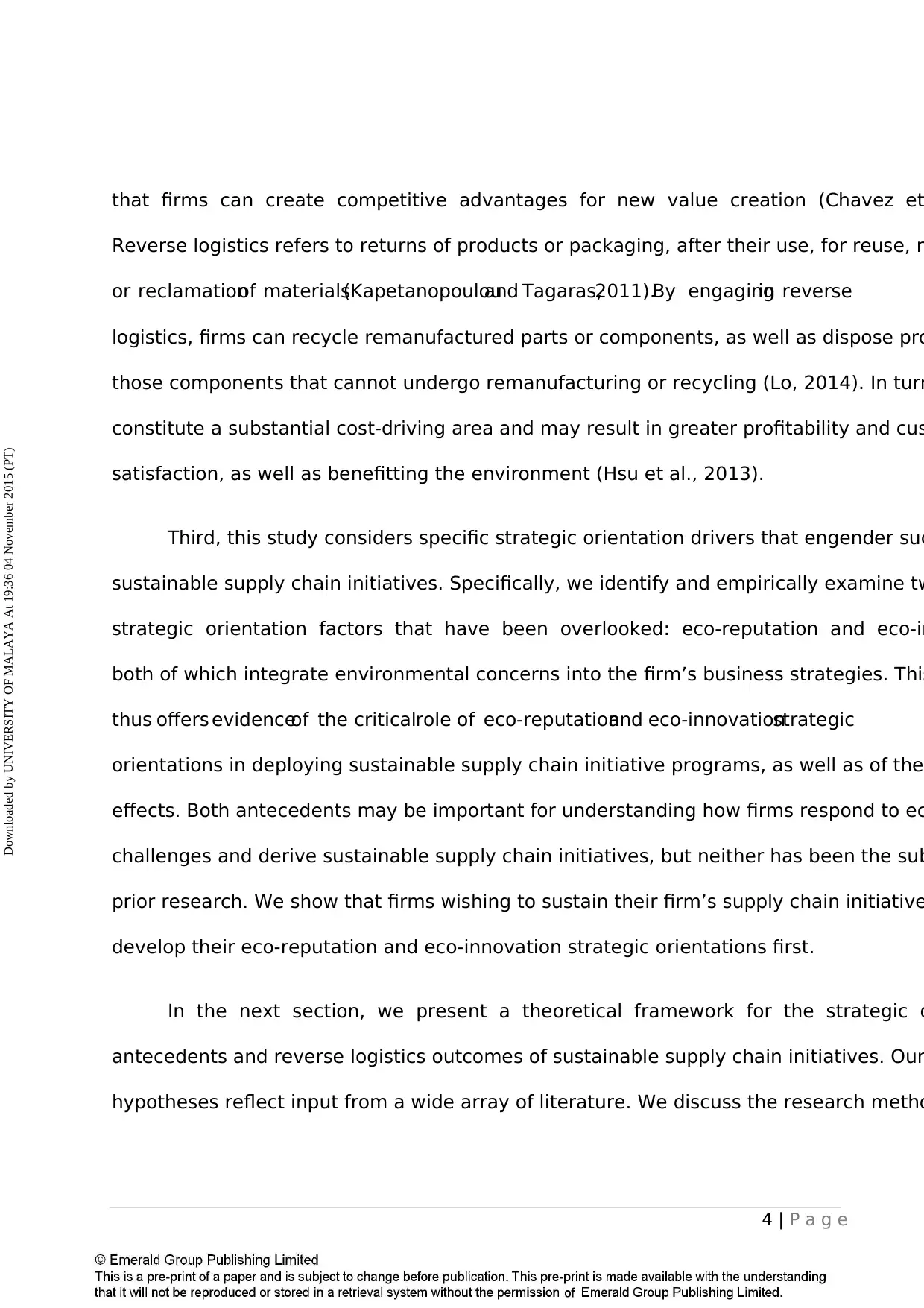
4 | P a g e
that firms can create competitive advantages for new value creation (Chavez et
Reverse logistics refers to returns of products or packaging, after their use, for reuse, r
or reclamationof materials(Kapetanopoulouand Tagaras,2011).By engagingin reverse
logistics, firms can recycle remanufactured parts or components, as well as dispose pro
those components that cannot undergo remanufacturing or recycling (Lo, 2014). In turn
constitute a substantial cost-driving area and may result in greater profitability and cus
satisfaction, as well as benefitting the environment (Hsu et al., 2013).
Third, this study considers specific strategic orientation drivers that engender suc
sustainable supply chain initiatives. Specifically, we identify and empirically examine tw
strategic orientation factors that have been overlooked: eco-reputation and eco-in
both of which integrate environmental concerns into the firm’s business strategies. This
thus offers evidenceof the criticalrole of eco-reputationand eco-innovationstrategic
orientations in deploying sustainable supply chain initiative programs, as well as of the
effects. Both antecedents may be important for understanding how firms respond to ec
challenges and derive sustainable supply chain initiatives, but neither has been the sub
prior research. We show that firms wishing to sustain their firm’s supply chain initiative
develop their eco-reputation and eco-innovation strategic orientations first.
In the next section, we present a theoretical framework for the strategic o
antecedents and reverse logistics outcomes of sustainable supply chain initiatives. Our
hypotheses reflect input from a wide array of literature. We discuss the research metho
Downloaded by UNIVERSITY OF MALAYA At 19:36 04 November 2015 (PT)
that firms can create competitive advantages for new value creation (Chavez et
Reverse logistics refers to returns of products or packaging, after their use, for reuse, r
or reclamationof materials(Kapetanopoulouand Tagaras,2011).By engagingin reverse
logistics, firms can recycle remanufactured parts or components, as well as dispose pro
those components that cannot undergo remanufacturing or recycling (Lo, 2014). In turn
constitute a substantial cost-driving area and may result in greater profitability and cus
satisfaction, as well as benefitting the environment (Hsu et al., 2013).
Third, this study considers specific strategic orientation drivers that engender suc
sustainable supply chain initiatives. Specifically, we identify and empirically examine tw
strategic orientation factors that have been overlooked: eco-reputation and eco-in
both of which integrate environmental concerns into the firm’s business strategies. This
thus offers evidenceof the criticalrole of eco-reputationand eco-innovationstrategic
orientations in deploying sustainable supply chain initiative programs, as well as of the
effects. Both antecedents may be important for understanding how firms respond to ec
challenges and derive sustainable supply chain initiatives, but neither has been the sub
prior research. We show that firms wishing to sustain their firm’s supply chain initiative
develop their eco-reputation and eco-innovation strategic orientations first.
In the next section, we present a theoretical framework for the strategic o
antecedents and reverse logistics outcomes of sustainable supply chain initiatives. Our
hypotheses reflect input from a wide array of literature. We discuss the research metho
Downloaded by UNIVERSITY OF MALAYA At 19:36 04 November 2015 (PT)
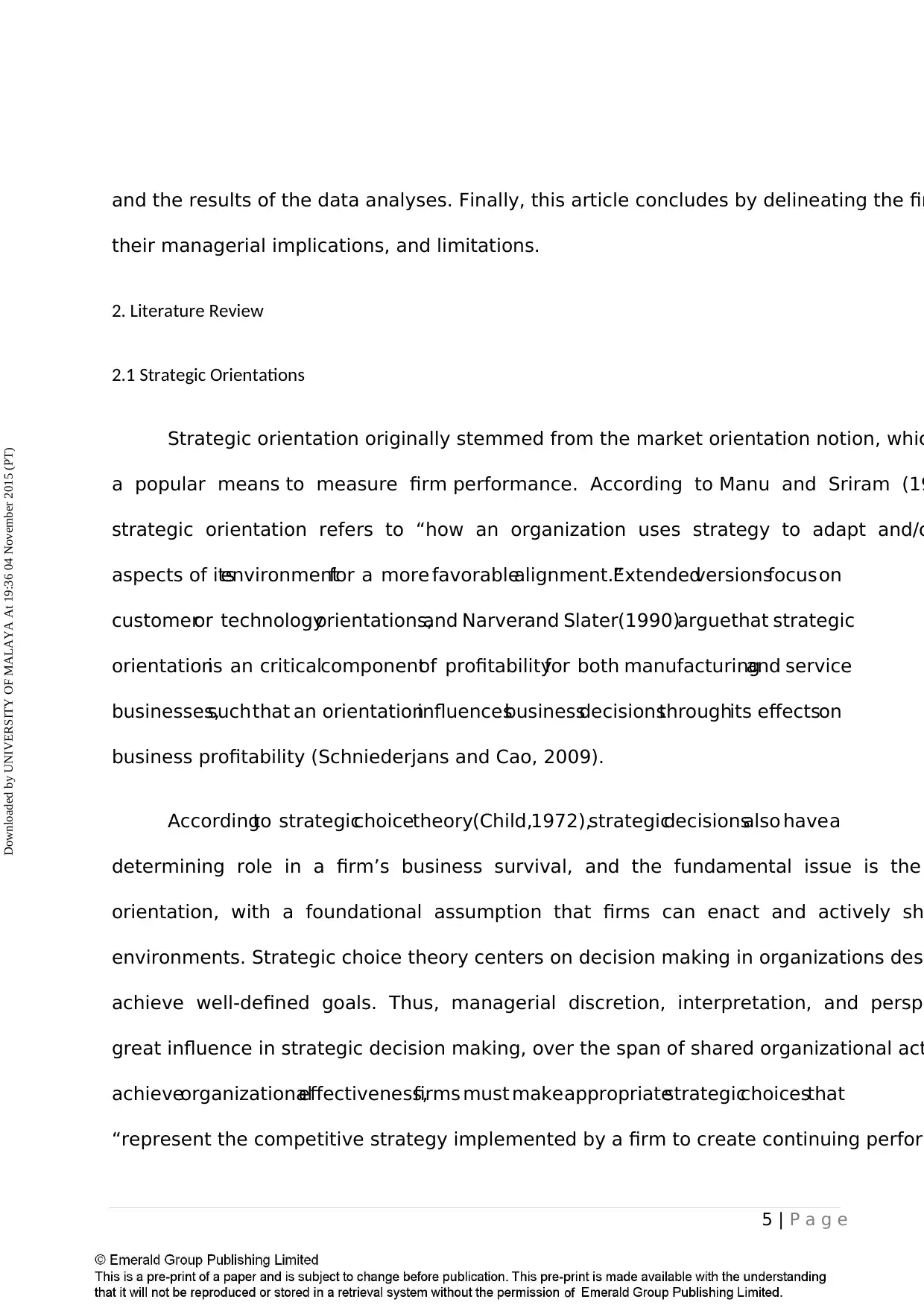
5 | P a g e
and the results of the data analyses. Finally, this article concludes by delineating the fin
their managerial implications, and limitations.
2. Literature Review
2.1 Strategic Orientations
Strategic orientation originally stemmed from the market orientation notion, whic
a popular means to measure firm performance. According to Manu and Sriram (19
strategic orientation refers to “how an organization uses strategy to adapt and/o
aspects of itsenvironmentfor a more favorablealignment.”Extendedversionsfocus on
customeror technologyorientations,and Narverand Slater(1990)arguethat strategic
orientationis an criticalcomponentof profitabilityfor both manufacturingand service
businesses,such that an orientationinfluencesbusinessdecisionsthroughits effectson
business profitability (Schniederjans and Cao, 2009).
Accordingto strategicchoicetheory(Child,1972),strategicdecisionsalso have a
determining role in a firm’s business survival, and the fundamental issue is the
orientation, with a foundational assumption that firms can enact and actively sh
environments. Strategic choice theory centers on decision making in organizations desi
achieve well-defined goals. Thus, managerial discretion, interpretation, and perspe
great influence in strategic decision making, over the span of shared organizational act
achieveorganizationaleffectiveness,firms must makeappropriatestrategicchoicesthat
“represent the competitive strategy implemented by a firm to create continuing perform
Downloaded by UNIVERSITY OF MALAYA At 19:36 04 November 2015 (PT)
and the results of the data analyses. Finally, this article concludes by delineating the fin
their managerial implications, and limitations.
2. Literature Review
2.1 Strategic Orientations
Strategic orientation originally stemmed from the market orientation notion, whic
a popular means to measure firm performance. According to Manu and Sriram (19
strategic orientation refers to “how an organization uses strategy to adapt and/o
aspects of itsenvironmentfor a more favorablealignment.”Extendedversionsfocus on
customeror technologyorientations,and Narverand Slater(1990)arguethat strategic
orientationis an criticalcomponentof profitabilityfor both manufacturingand service
businesses,such that an orientationinfluencesbusinessdecisionsthroughits effectson
business profitability (Schniederjans and Cao, 2009).
Accordingto strategicchoicetheory(Child,1972),strategicdecisionsalso have a
determining role in a firm’s business survival, and the fundamental issue is the
orientation, with a foundational assumption that firms can enact and actively sh
environments. Strategic choice theory centers on decision making in organizations desi
achieve well-defined goals. Thus, managerial discretion, interpretation, and perspe
great influence in strategic decision making, over the span of shared organizational act
achieveorganizationaleffectiveness,firms must makeappropriatestrategicchoicesthat
“represent the competitive strategy implemented by a firm to create continuing perform
Downloaded by UNIVERSITY OF MALAYA At 19:36 04 November 2015 (PT)
⊘ This is a preview!⊘
Do you want full access?
Subscribe today to unlock all pages.

Trusted by 1+ million students worldwide
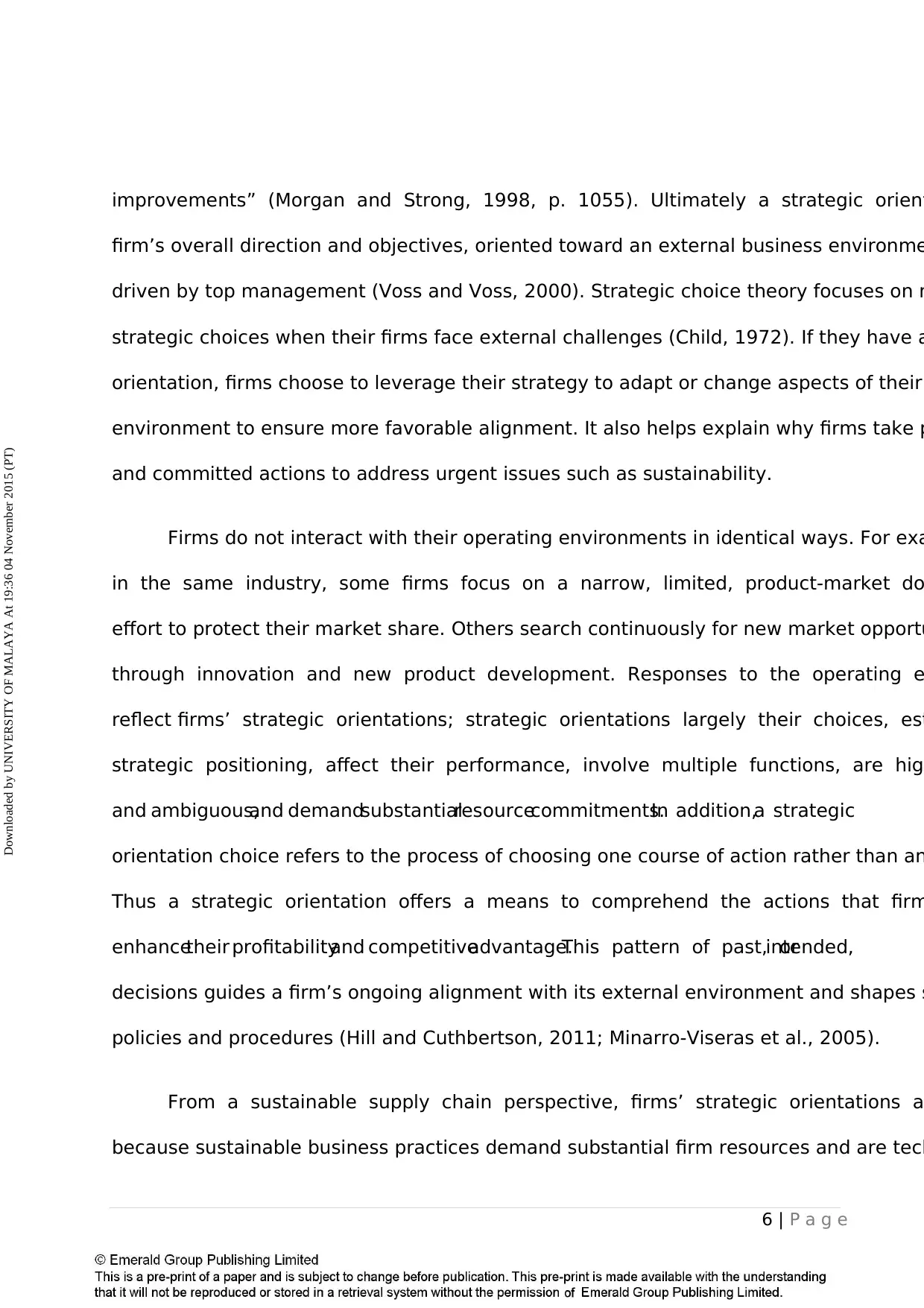
6 | P a g e
improvements” (Morgan and Strong, 1998, p. 1055). Ultimately a strategic orient
firm’s overall direction and objectives, oriented toward an external business environme
driven by top management (Voss and Voss, 2000). Strategic choice theory focuses on m
strategic choices when their firms face external challenges (Child, 1972). If they have a
orientation, firms choose to leverage their strategy to adapt or change aspects of their
environment to ensure more favorable alignment. It also helps explain why firms take p
and committed actions to address urgent issues such as sustainability.
Firms do not interact with their operating environments in identical ways. For exa
in the same industry, some firms focus on a narrow, limited, product-market do
effort to protect their market share. Others search continuously for new market opportu
through innovation and new product development. Responses to the operating e
reflect firms’ strategic orientations; strategic orientations largely their choices, est
strategic positioning, affect their performance, involve multiple functions, are hig
and ambiguous,and demandsubstantialresourcecommitments.In addition,a strategic
orientation choice refers to the process of choosing one course of action rather than an
Thus a strategic orientation offers a means to comprehend the actions that firm
enhancetheir profitabilityand competitiveadvantage.This pattern of past, orintended,
decisions guides a firm’s ongoing alignment with its external environment and shapes s
policies and procedures (Hill and Cuthbertson, 2011; Minarro-Viseras et al., 2005).
From a sustainable supply chain perspective, firms’ strategic orientations a
because sustainable business practices demand substantial firm resources and are tech
Downloaded by UNIVERSITY OF MALAYA At 19:36 04 November 2015 (PT)
improvements” (Morgan and Strong, 1998, p. 1055). Ultimately a strategic orient
firm’s overall direction and objectives, oriented toward an external business environme
driven by top management (Voss and Voss, 2000). Strategic choice theory focuses on m
strategic choices when their firms face external challenges (Child, 1972). If they have a
orientation, firms choose to leverage their strategy to adapt or change aspects of their
environment to ensure more favorable alignment. It also helps explain why firms take p
and committed actions to address urgent issues such as sustainability.
Firms do not interact with their operating environments in identical ways. For exa
in the same industry, some firms focus on a narrow, limited, product-market do
effort to protect their market share. Others search continuously for new market opportu
through innovation and new product development. Responses to the operating e
reflect firms’ strategic orientations; strategic orientations largely their choices, est
strategic positioning, affect their performance, involve multiple functions, are hig
and ambiguous,and demandsubstantialresourcecommitments.In addition,a strategic
orientation choice refers to the process of choosing one course of action rather than an
Thus a strategic orientation offers a means to comprehend the actions that firm
enhancetheir profitabilityand competitiveadvantage.This pattern of past, orintended,
decisions guides a firm’s ongoing alignment with its external environment and shapes s
policies and procedures (Hill and Cuthbertson, 2011; Minarro-Viseras et al., 2005).
From a sustainable supply chain perspective, firms’ strategic orientations a
because sustainable business practices demand substantial firm resources and are tech
Downloaded by UNIVERSITY OF MALAYA At 19:36 04 November 2015 (PT)
Paraphrase This Document
Need a fresh take? Get an instant paraphrase of this document with our AI Paraphraser
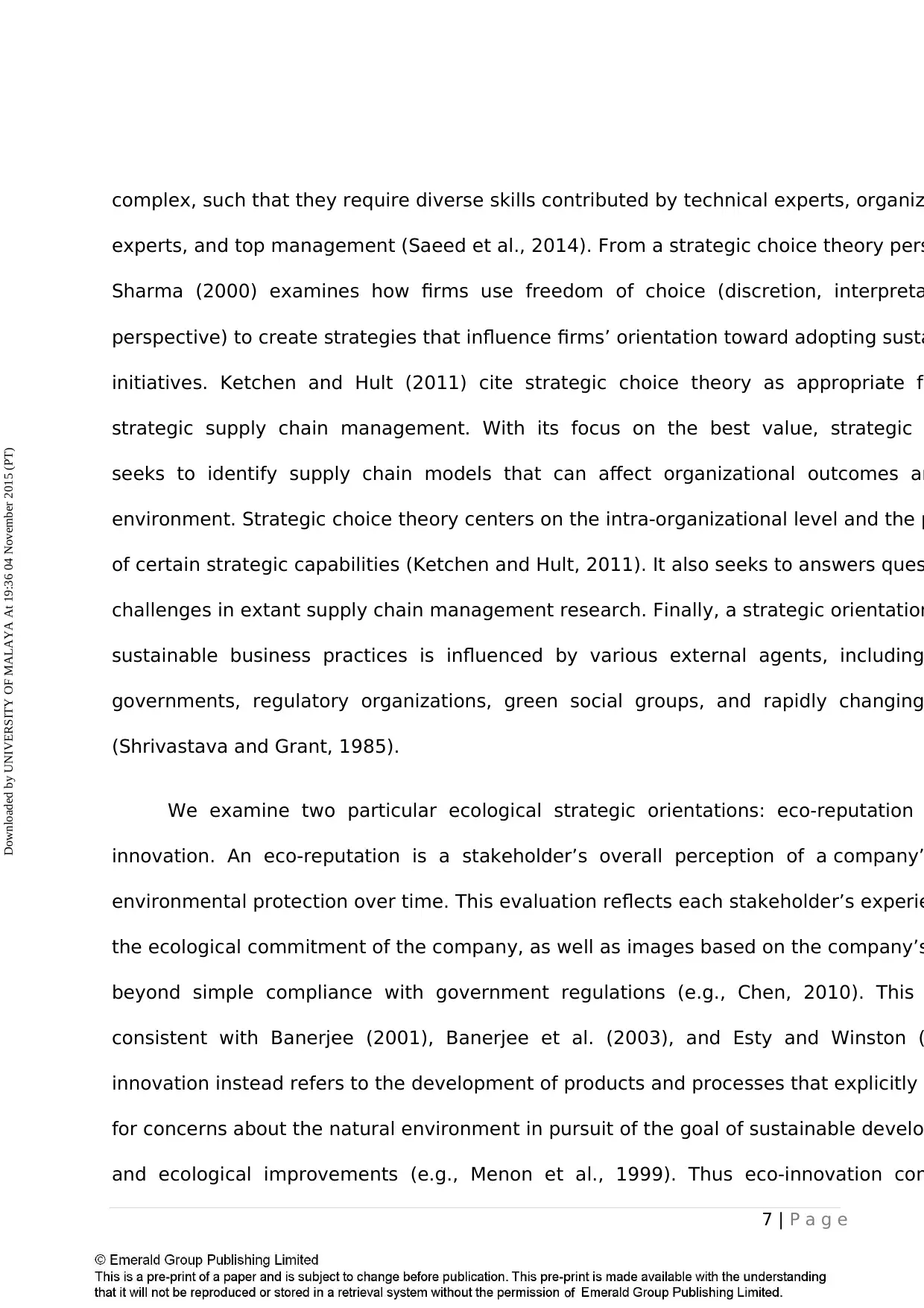
7 | P a g e
complex, such that they require diverse skills contributed by technical experts, organiz
experts, and top management (Saeed et al., 2014). From a strategic choice theory pers
Sharma (2000) examines how firms use freedom of choice (discretion, interpreta
perspective) to create strategies that influence firms’ orientation toward adopting susta
initiatives. Ketchen and Hult (2011) cite strategic choice theory as appropriate fo
strategic supply chain management. With its focus on the best value, strategic
seeks to identify supply chain models that can affect organizational outcomes an
environment. Strategic choice theory centers on the intra-organizational level and the p
of certain strategic capabilities (Ketchen and Hult, 2011). It also seeks to answers ques
challenges in extant supply chain management research. Finally, a strategic orientation
sustainable business practices is influenced by various external agents, including
governments, regulatory organizations, green social groups, and rapidly changing
(Shrivastava and Grant, 1985).
We examine two particular ecological strategic orientations: eco-reputation
innovation. An eco-reputation is a stakeholder’s overall perception of a company’
environmental protection over time. This evaluation reflects each stakeholder’s experie
the ecological commitment of the company, as well as images based on the company’s
beyond simple compliance with government regulations (e.g., Chen, 2010). This
consistent with Banerjee (2001), Banerjee et al. (2003), and Esty and Winston (
innovation instead refers to the development of products and processes that explicitly
for concerns about the natural environment in pursuit of the goal of sustainable develo
and ecological improvements (e.g., Menon et al., 1999). Thus eco-innovation con
Downloaded by UNIVERSITY OF MALAYA At 19:36 04 November 2015 (PT)
complex, such that they require diverse skills contributed by technical experts, organiz
experts, and top management (Saeed et al., 2014). From a strategic choice theory pers
Sharma (2000) examines how firms use freedom of choice (discretion, interpreta
perspective) to create strategies that influence firms’ orientation toward adopting susta
initiatives. Ketchen and Hult (2011) cite strategic choice theory as appropriate fo
strategic supply chain management. With its focus on the best value, strategic
seeks to identify supply chain models that can affect organizational outcomes an
environment. Strategic choice theory centers on the intra-organizational level and the p
of certain strategic capabilities (Ketchen and Hult, 2011). It also seeks to answers ques
challenges in extant supply chain management research. Finally, a strategic orientation
sustainable business practices is influenced by various external agents, including
governments, regulatory organizations, green social groups, and rapidly changing
(Shrivastava and Grant, 1985).
We examine two particular ecological strategic orientations: eco-reputation
innovation. An eco-reputation is a stakeholder’s overall perception of a company’
environmental protection over time. This evaluation reflects each stakeholder’s experie
the ecological commitment of the company, as well as images based on the company’s
beyond simple compliance with government regulations (e.g., Chen, 2010). This
consistent with Banerjee (2001), Banerjee et al. (2003), and Esty and Winston (
innovation instead refers to the development of products and processes that explicitly
for concerns about the natural environment in pursuit of the goal of sustainable develo
and ecological improvements (e.g., Menon et al., 1999). Thus eco-innovation con
Downloaded by UNIVERSITY OF MALAYA At 19:36 04 November 2015 (PT)
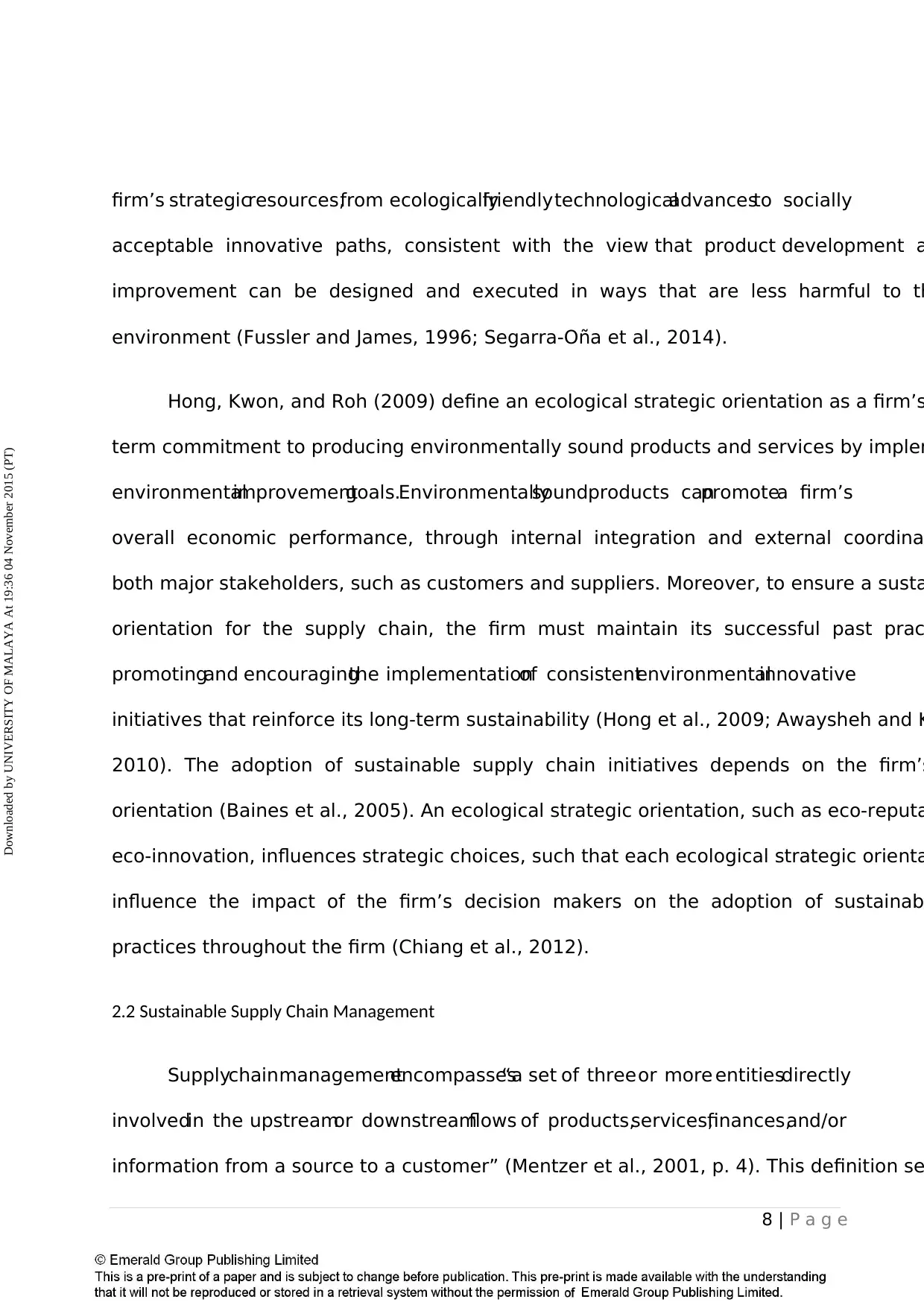
8 | P a g e
firm’s strategicresources,from ecologicallyfriendly technologicaladvancesto socially
acceptable innovative paths, consistent with the view that product development a
improvement can be designed and executed in ways that are less harmful to th
environment (Fussler and James, 1996; Segarra-Oña et al., 2014).
Hong, Kwon, and Roh (2009) define an ecological strategic orientation as a firm’s
term commitment to producing environmentally sound products and services by implem
environmentalimprovementgoals.Environmentallysoundproducts canpromotea firm’s
overall economic performance, through internal integration and external coordina
both major stakeholders, such as customers and suppliers. Moreover, to ensure a susta
orientation for the supply chain, the firm must maintain its successful past prac
promotingand encouragingthe implementationof consistentenvironmentalinnovative
initiatives that reinforce its long-term sustainability (Hong et al., 2009; Awaysheh and K
2010). The adoption of sustainable supply chain initiatives depends on the firm’s
orientation (Baines et al., 2005). An ecological strategic orientation, such as eco-reputa
eco-innovation, influences strategic choices, such that each ecological strategic orienta
influence the impact of the firm’s decision makers on the adoption of sustainab
practices throughout the firm (Chiang et al., 2012).
2.2 Sustainable Supply Chain Management
Supplychainmanagementencompasses“a set of three or more entitiesdirectly
involvedin the upstreamor downstreamflows of products,services,finances,and/or
information from a source to a customer” (Mentzer et al., 2001, p. 4). This definition se
Downloaded by UNIVERSITY OF MALAYA At 19:36 04 November 2015 (PT)
firm’s strategicresources,from ecologicallyfriendly technologicaladvancesto socially
acceptable innovative paths, consistent with the view that product development a
improvement can be designed and executed in ways that are less harmful to th
environment (Fussler and James, 1996; Segarra-Oña et al., 2014).
Hong, Kwon, and Roh (2009) define an ecological strategic orientation as a firm’s
term commitment to producing environmentally sound products and services by implem
environmentalimprovementgoals.Environmentallysoundproducts canpromotea firm’s
overall economic performance, through internal integration and external coordina
both major stakeholders, such as customers and suppliers. Moreover, to ensure a susta
orientation for the supply chain, the firm must maintain its successful past prac
promotingand encouragingthe implementationof consistentenvironmentalinnovative
initiatives that reinforce its long-term sustainability (Hong et al., 2009; Awaysheh and K
2010). The adoption of sustainable supply chain initiatives depends on the firm’s
orientation (Baines et al., 2005). An ecological strategic orientation, such as eco-reputa
eco-innovation, influences strategic choices, such that each ecological strategic orienta
influence the impact of the firm’s decision makers on the adoption of sustainab
practices throughout the firm (Chiang et al., 2012).
2.2 Sustainable Supply Chain Management
Supplychainmanagementencompasses“a set of three or more entitiesdirectly
involvedin the upstreamor downstreamflows of products,services,finances,and/or
information from a source to a customer” (Mentzer et al., 2001, p. 4). This definition se
Downloaded by UNIVERSITY OF MALAYA At 19:36 04 November 2015 (PT)
⊘ This is a preview!⊘
Do you want full access?
Subscribe today to unlock all pages.

Trusted by 1+ million students worldwide
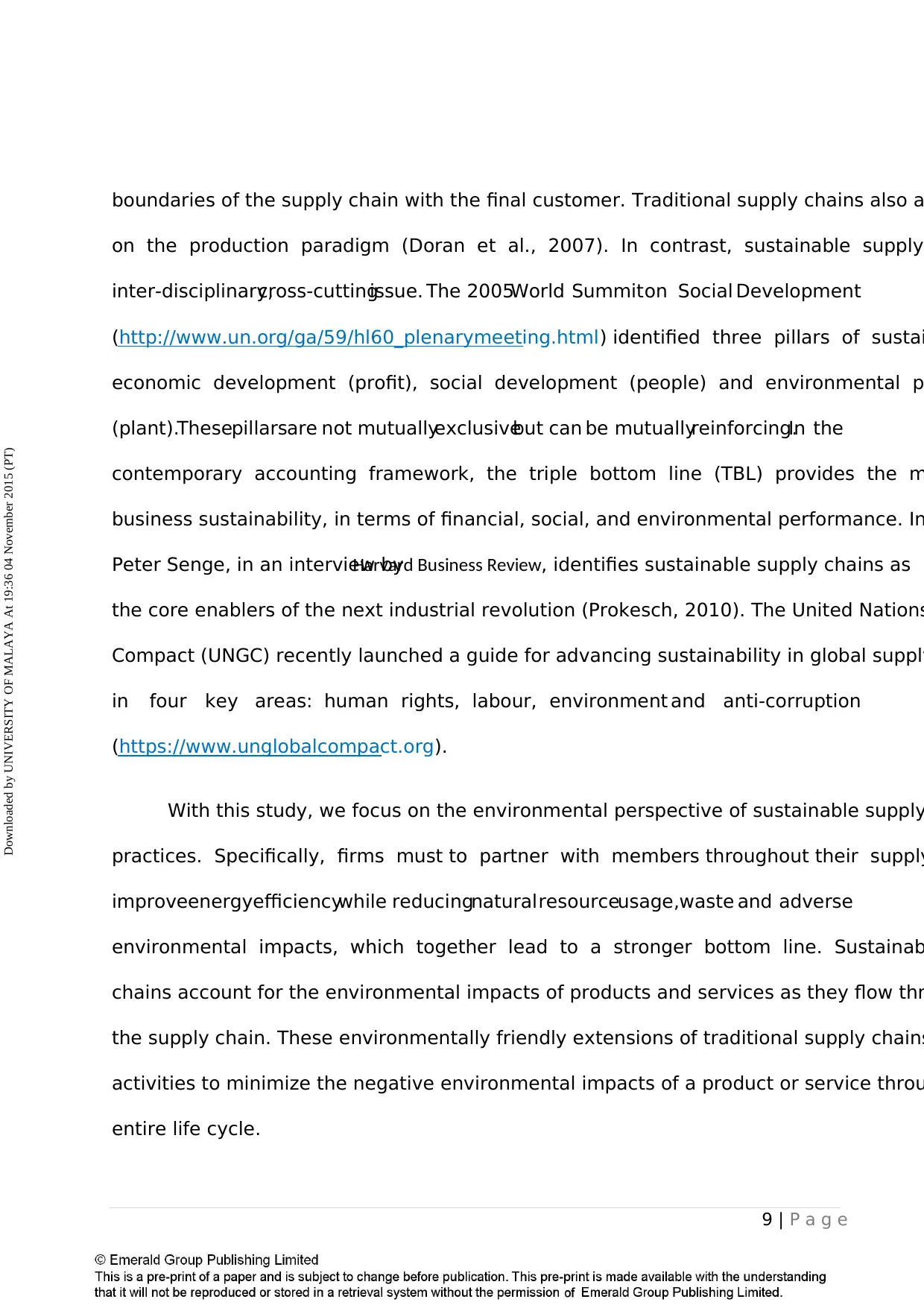
9 | P a g e
boundaries of the supply chain with the final customer. Traditional supply chains also a
on the production paradigm (Doran et al., 2007). In contrast, sustainable supply
inter-disciplinary,cross-cuttingissue. The 2005World Summit on Social Development
(http://www.un.org/ga/59/hl60_plenarymeeting.html) identified three pillars of sustai
economic development (profit), social development (people) and environmental p
(plant).Thesepillarsare not mutuallyexclusivebut can be mutuallyreinforcing.In the
contemporary accounting framework, the triple bottom line (TBL) provides the m
business sustainability, in terms of financial, social, and environmental performance. In
Peter Senge, in an interview byHarvard Business Review, identifies sustainable supply chains as
the core enablers of the next industrial revolution (Prokesch, 2010). The United Nations
Compact (UNGC) recently launched a guide for advancing sustainability in global supply
in four key areas: human rights, labour, environment and anti-corruption
(https://www.unglobalcompact.org).
With this study, we focus on the environmental perspective of sustainable supply
practices. Specifically, firms must to partner with members throughout their supply
improveenergyefficiencywhile reducingnatural resourceusage,waste and adverse
environmental impacts, which together lead to a stronger bottom line. Sustainab
chains account for the environmental impacts of products and services as they flow thr
the supply chain. These environmentally friendly extensions of traditional supply chains
activities to minimize the negative environmental impacts of a product or service throu
entire life cycle.
Downloaded by UNIVERSITY OF MALAYA At 19:36 04 November 2015 (PT)
boundaries of the supply chain with the final customer. Traditional supply chains also a
on the production paradigm (Doran et al., 2007). In contrast, sustainable supply
inter-disciplinary,cross-cuttingissue. The 2005World Summit on Social Development
(http://www.un.org/ga/59/hl60_plenarymeeting.html) identified three pillars of sustai
economic development (profit), social development (people) and environmental p
(plant).Thesepillarsare not mutuallyexclusivebut can be mutuallyreinforcing.In the
contemporary accounting framework, the triple bottom line (TBL) provides the m
business sustainability, in terms of financial, social, and environmental performance. In
Peter Senge, in an interview byHarvard Business Review, identifies sustainable supply chains as
the core enablers of the next industrial revolution (Prokesch, 2010). The United Nations
Compact (UNGC) recently launched a guide for advancing sustainability in global supply
in four key areas: human rights, labour, environment and anti-corruption
(https://www.unglobalcompact.org).
With this study, we focus on the environmental perspective of sustainable supply
practices. Specifically, firms must to partner with members throughout their supply
improveenergyefficiencywhile reducingnatural resourceusage,waste and adverse
environmental impacts, which together lead to a stronger bottom line. Sustainab
chains account for the environmental impacts of products and services as they flow thr
the supply chain. These environmentally friendly extensions of traditional supply chains
activities to minimize the negative environmental impacts of a product or service throu
entire life cycle.
Downloaded by UNIVERSITY OF MALAYA At 19:36 04 November 2015 (PT)
Paraphrase This Document
Need a fresh take? Get an instant paraphrase of this document with our AI Paraphraser
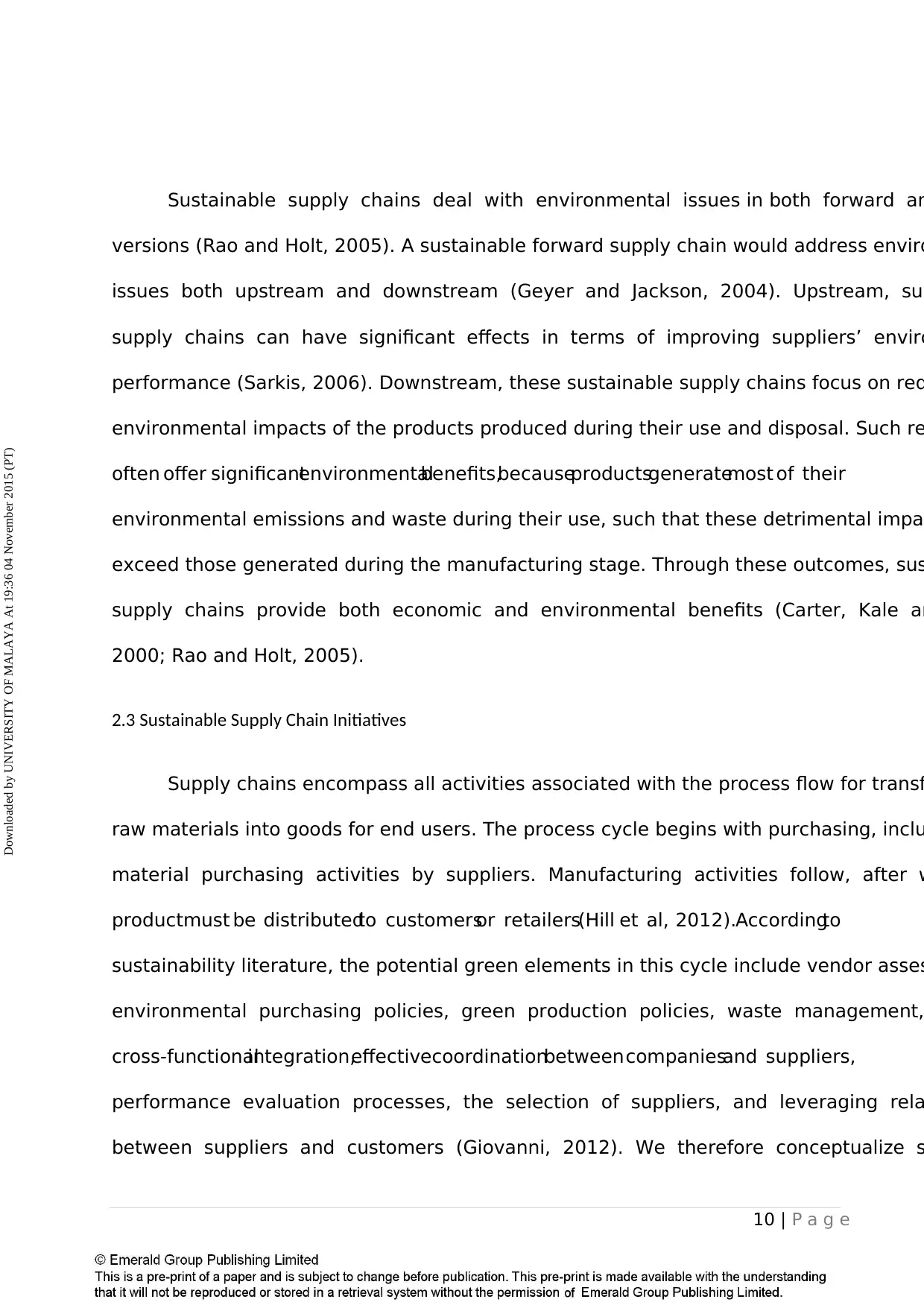
10 | P a g e
Sustainable supply chains deal with environmental issues in both forward an
versions (Rao and Holt, 2005). A sustainable forward supply chain would address enviro
issues both upstream and downstream (Geyer and Jackson, 2004). Upstream, sus
supply chains can have significant effects in terms of improving suppliers’ enviro
performance (Sarkis, 2006). Downstream, these sustainable supply chains focus on red
environmental impacts of the products produced during their use and disposal. Such re
often offer significantenvironmentalbenefits,becauseproductsgeneratemost of their
environmental emissions and waste during their use, such that these detrimental impa
exceed those generated during the manufacturing stage. Through these outcomes, sus
supply chains provide both economic and environmental benefits (Carter, Kale an
2000; Rao and Holt, 2005).
2.3 Sustainable Supply Chain Initiatives
Supply chains encompass all activities associated with the process flow for transf
raw materials into goods for end users. The process cycle begins with purchasing, inclu
material purchasing activities by suppliers. Manufacturing activities follow, after w
productmust be distributedto customersor retailers(Hill et al, 2012).Accordingto
sustainability literature, the potential green elements in this cycle include vendor asses
environmental purchasing policies, green production policies, waste management,
cross-functionalintegration,effectivecoordinationbetween companiesand suppliers,
performance evaluation processes, the selection of suppliers, and leveraging rela
between suppliers and customers (Giovanni, 2012). We therefore conceptualize s
Downloaded by UNIVERSITY OF MALAYA At 19:36 04 November 2015 (PT)
Sustainable supply chains deal with environmental issues in both forward an
versions (Rao and Holt, 2005). A sustainable forward supply chain would address enviro
issues both upstream and downstream (Geyer and Jackson, 2004). Upstream, sus
supply chains can have significant effects in terms of improving suppliers’ enviro
performance (Sarkis, 2006). Downstream, these sustainable supply chains focus on red
environmental impacts of the products produced during their use and disposal. Such re
often offer significantenvironmentalbenefits,becauseproductsgeneratemost of their
environmental emissions and waste during their use, such that these detrimental impa
exceed those generated during the manufacturing stage. Through these outcomes, sus
supply chains provide both economic and environmental benefits (Carter, Kale an
2000; Rao and Holt, 2005).
2.3 Sustainable Supply Chain Initiatives
Supply chains encompass all activities associated with the process flow for transf
raw materials into goods for end users. The process cycle begins with purchasing, inclu
material purchasing activities by suppliers. Manufacturing activities follow, after w
productmust be distributedto customersor retailers(Hill et al, 2012).Accordingto
sustainability literature, the potential green elements in this cycle include vendor asses
environmental purchasing policies, green production policies, waste management,
cross-functionalintegration,effectivecoordinationbetween companiesand suppliers,
performance evaluation processes, the selection of suppliers, and leveraging rela
between suppliers and customers (Giovanni, 2012). We therefore conceptualize s
Downloaded by UNIVERSITY OF MALAYA At 19:36 04 November 2015 (PT)
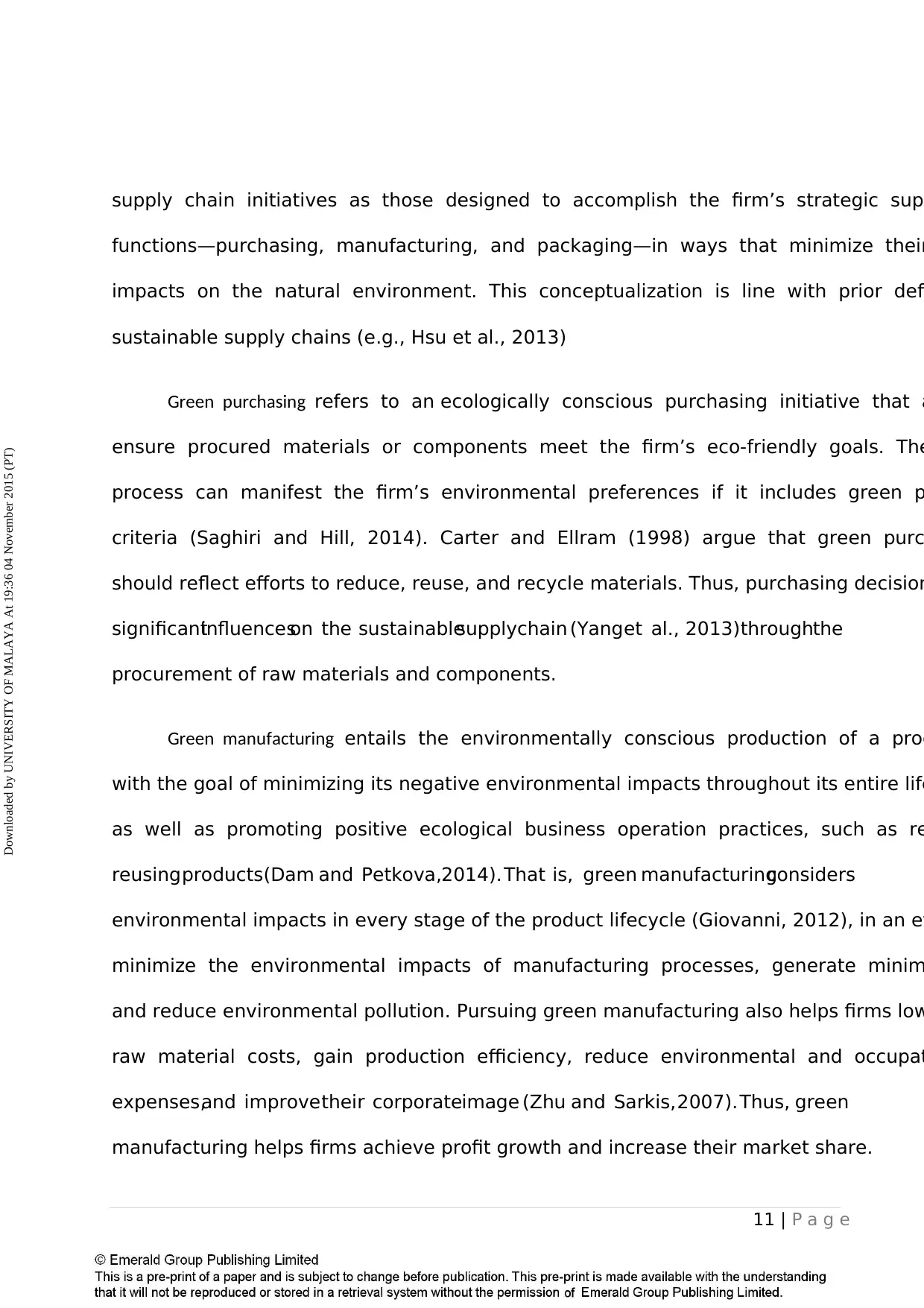
11 | P a g e
supply chain initiatives as those designed to accomplish the firm’s strategic sup
functions—purchasing, manufacturing, and packaging—in ways that minimize their
impacts on the natural environment. This conceptualization is line with prior defi
sustainable supply chains (e.g., Hsu et al., 2013)
Green purchasing refers to an ecologically conscious purchasing initiative that a
ensure procured materials or components meet the firm’s eco-friendly goals. The
process can manifest the firm’s environmental preferences if it includes green p
criteria (Saghiri and Hill, 2014). Carter and Ellram (1998) argue that green purc
should reflect efforts to reduce, reuse, and recycle materials. Thus, purchasing decision
significantinfluenceson the sustainablesupplychain (Yanget al., 2013)throughthe
procurement of raw materials and components.
Green manufacturing entails the environmentally conscious production of a prod
with the goal of minimizing its negative environmental impacts throughout its entire life
as well as promoting positive ecological business operation practices, such as re
reusing products(Dam and Petkova,2014). That is, green manufacturingconsiders
environmental impacts in every stage of the product lifecycle (Giovanni, 2012), in an eff
minimize the environmental impacts of manufacturing processes, generate minim
and reduce environmental pollution. Pursuing green manufacturing also helps firms low
raw material costs, gain production efficiency, reduce environmental and occupat
expenses,and improve their corporateimage (Zhu and Sarkis, 2007). Thus, green
manufacturing helps firms achieve profit growth and increase their market share.
Downloaded by UNIVERSITY OF MALAYA At 19:36 04 November 2015 (PT)
supply chain initiatives as those designed to accomplish the firm’s strategic sup
functions—purchasing, manufacturing, and packaging—in ways that minimize their
impacts on the natural environment. This conceptualization is line with prior defi
sustainable supply chains (e.g., Hsu et al., 2013)
Green purchasing refers to an ecologically conscious purchasing initiative that a
ensure procured materials or components meet the firm’s eco-friendly goals. The
process can manifest the firm’s environmental preferences if it includes green p
criteria (Saghiri and Hill, 2014). Carter and Ellram (1998) argue that green purc
should reflect efforts to reduce, reuse, and recycle materials. Thus, purchasing decision
significantinfluenceson the sustainablesupplychain (Yanget al., 2013)throughthe
procurement of raw materials and components.
Green manufacturing entails the environmentally conscious production of a prod
with the goal of minimizing its negative environmental impacts throughout its entire life
as well as promoting positive ecological business operation practices, such as re
reusing products(Dam and Petkova,2014). That is, green manufacturingconsiders
environmental impacts in every stage of the product lifecycle (Giovanni, 2012), in an eff
minimize the environmental impacts of manufacturing processes, generate minim
and reduce environmental pollution. Pursuing green manufacturing also helps firms low
raw material costs, gain production efficiency, reduce environmental and occupat
expenses,and improve their corporateimage (Zhu and Sarkis, 2007). Thus, green
manufacturing helps firms achieve profit growth and increase their market share.
Downloaded by UNIVERSITY OF MALAYA At 19:36 04 November 2015 (PT)
⊘ This is a preview!⊘
Do you want full access?
Subscribe today to unlock all pages.

Trusted by 1+ million students worldwide
1 out of 45
Your All-in-One AI-Powered Toolkit for Academic Success.
+13062052269
info@desklib.com
Available 24*7 on WhatsApp / Email
![[object Object]](/_next/static/media/star-bottom.7253800d.svg)
Unlock your academic potential
Copyright © 2020–2025 A2Z Services. All Rights Reserved. Developed and managed by ZUCOL.